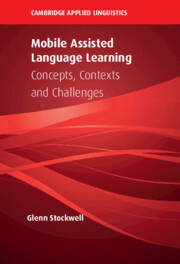Book contents
- Mobile Assisted Language Learning
- The Cambridge Applied Linguistics Series
- Mobile Assisted Language Learning
- Copyright page
- Dedication
- Contents
- Figures
- Tables
- Acknowledgements
- Abbreviations
- 1 Introduction
- 2 Fundamental Considerations of Teaching with Mobile Technologies
- 3 Shifting Paradigms in Language Learning and Teaching
- 4 Research Considerations in MALL
- 5 Theory in MALL
- 6 Physical, Psychosocial and Pedagogical Issues
- 7 The Learner in MALL
- 8 Designing MALL Environments
- 9 Concepts, Contexts and Challenges in MALL
- Glossary
- References
- Index
2 - Fundamental Considerations of Teaching with Mobile Technologies
Published online by Cambridge University Press: 23 December 2021
- Mobile Assisted Language Learning
- The Cambridge Applied Linguistics Series
- Mobile Assisted Language Learning
- Copyright page
- Dedication
- Contents
- Figures
- Tables
- Acknowledgements
- Abbreviations
- 1 Introduction
- 2 Fundamental Considerations of Teaching with Mobile Technologies
- 3 Shifting Paradigms in Language Learning and Teaching
- 4 Research Considerations in MALL
- 5 Theory in MALL
- 6 Physical, Psychosocial and Pedagogical Issues
- 7 The Learner in MALL
- 8 Designing MALL Environments
- 9 Concepts, Contexts and Challenges in MALL
- Glossary
- References
- Index
Summary
This chapter explores parallels between CALL and MALL and outlines how the technological affordances of various devices affect the ways in which they are used to achieve specific goals. The chapter describes the interrelationship of technology, research, practice and theory; outlines the evolution of mobile technologies and emphasises the importance of moving from affordance-based practice to pedagogy-based practice as technologies move through the hype cycle (cf. Gartner, 2016). The issue of push and pull modes associated with mobile technologies is outlined here, along with the ability of mobile devices to interact with other devices through a range of networking functions, the potential for mixed-reality learning and context-sensitive learning, and the use of other functions such as cameras and audio recorders for language learning. The chapter continues by pointing out some of the limitations of research on technology use in language education and then considers some of the complexities of both theory and practice in MALL in order to lay the foundations for the later chapters.
- Type
- Chapter
- Information
- Mobile Assisted Language LearningConcepts, Contexts and Challenges, pp. 21 - 44Publisher: Cambridge University PressPrint publication year: 2022

